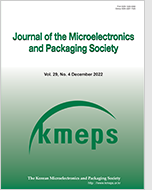
Search
- Past Issues
- e-Submission
-

KCI Accredited Journals KCI 등재지
KCI Impact Factor 0.54
Editorial Office
- +82-2-538-0962
- +82-2-538-0963
- kmeps@kmeps.or.kr
- http://kmeps.or.kr/

KCI Accredited Journals KCI 등재지
KCI Impact Factor 0.54
Journal of the Microelectronics and Packaging Society 2024;31(4):76-82. Published online: Jan, 22, 2025
DOI : doi.org/10.6117/kmeps.2024.31.4.076
Recently, there has been a lot of research into glass as a material for interposer substrates used in 2.5D packaging technologies. Femtosecond lasers have been widely used to form TGV (through glass via) structures on glass interposers. However, damage caused by thermoelastic waves and shock waves during the TGV fabrication process using femtosecond lasers can limit the formation of vias with fine pitch, making it crucial to minimize damage during processing the damage caused by thermoelastic and shock waves during the processing of TGVs with femtosecond lasers is a challenge in forming closely spaced vias. In this study, we propose to reduce the via spacing while suppressing the damage caused by the single mode to the around of the via by using the burst mode in which the single pulse of the femtosecond laser is distributed and oscillated, and to analyze the mechanical properties around the via processed by single mode and burst mode through nanoindenter to suggest that the reason for the damage is related to the elastic modulus.
Keywords Femtosecond laser, Through glass via, Burst mode, Fine pitch